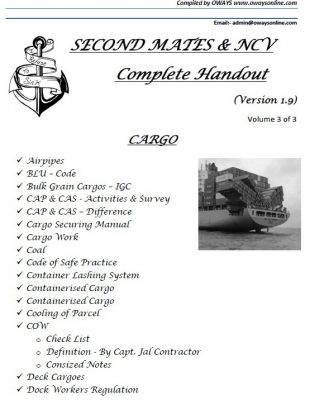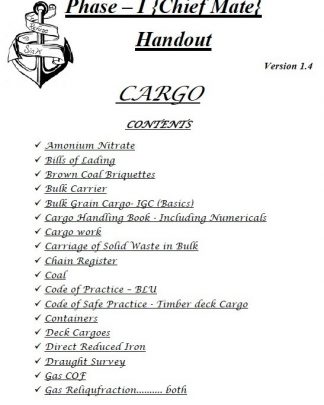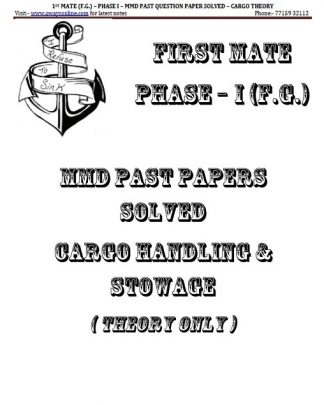Testing of Hatch Covers – Weather Tightness:
After maintenance procedure it is advised to test the water tight integrity of the hatch cover by different methods. The three methods to check water tightness of hold covers are:
Hose water Test:
In this test a water spray from a nozzle of 12mm diameter is sprayed over the joint of hold and cover from a distance of 1m to 1.5 m with a pressure of 0.5 m/ second water jet.
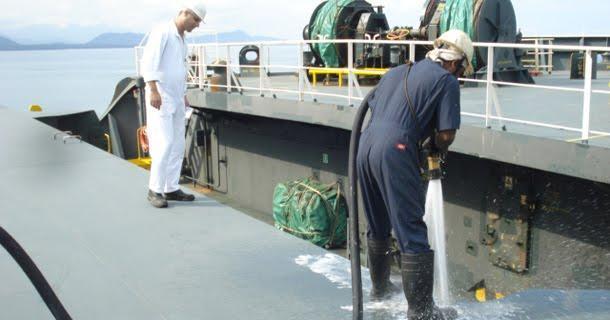
- The limitation or drawbacks of this test is that it requires two persons and hatch cover to be tested must be empty.
- The leakage if very minimal cannot be identified by naked eye and cannot be performed in sub zero or cold weather.
Advantages:-
- The hose test is the traditional way of testing hatch covers.
- It is an inexpensive method as a fire hose with nozzle & a good water pressure from the fire pump is the only primary requirement.
- It can be useful to have good results of hatch cover tests entered in the logbook.
Disadvantages:-
- Surplus amount of sea water required for performing the test.
- Sometimes have resulted in cargo damage.
- From a surveyor’s point of view, the hose test also has the disadvantage of not being fool proof. The surveyor will not be able to observe how the spraying is performed on the outside, while he is the cargo hold looking for leakages.
- If a hard water jet is not armed directly over the hatch cover joints, then the test may prove worthless.
Chalk Test:
- The Chalk Test is often carried out when the vessel is new in the shipyard.
- All the compression bars are rigorously rubbed with a piece of chalk thereafter the hatch covers are put in place & secured and then opened again.
- If there has been insufficient compression between the compression box and the hatch cover gasket there will be lack of or incomplete chalk marks in such areas of gaskets.
Advantages:-
- It clearly defines the persisting problem in achieving weather tightness.
- It also marks if the gasket lands off-centre on the compression bar.
Disadvantages:-
- Surplus amount of chalk required to cover the full periphery of the compression bar length.
- The method is rather time consuming and can only be used in dry weather.
Ultra Apparatus Test:
One of the possible applications for using ultrasounds in the marine industry consists of testing the weathertight integrity of hatch covers, weathertight doors, ventilators, on board of ships. The testing principle is based on the generation of a distinctive ultrasonic signal by using a transmitter (SDT 200mW for small compartments and SDT 8 MS for larger compartments) which is placed inside the compartment to be tested. Through reflection, the ultrasounds generated by the transmitter will fill up the cargo hold.
Ultrasounds passing through sealing arrangements, cracks, holes etc. can easily be picked up and measured by the SDT Sherlog ultrasonic receiver equipped with a handy flexible sensor.
Positioning the transmitter in the hold Checking sealing arrangements for leaks:-
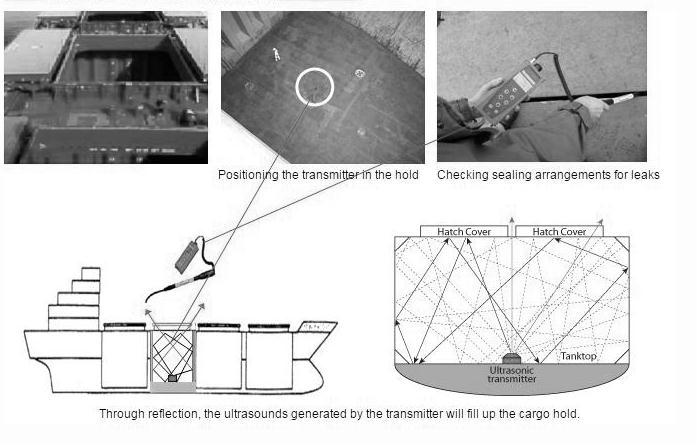
Advantages:-
Testing hatch covers, or other cargo access equipment such as bow-doors, visors, ramps, etc., with ultrasonic testing equipment offers the surveyor or inspector several advantages. The most important benefits of using ultrasonic testing material are:
Reliable, Non-destructive, repeatable testing method:
- Detection of areas where lack of compression exists with pin-point accuracy (no time consuming investigation needed for finding the leaks, as the leak can be pin-pointed local repairs might be sufficient and adequate,….).
- Information about compression status.
- Quick and easy testing, without assistance from ship’s crew (except for supervision and safety aspects).
- Possibility to use the equipment in holds loaded with water susceptible cargo.
- Possibility to test hatch covers irrespective of weather conditions.
- Testing for weathertightness and air/gas tightness.
- Identification of leaks without the use of a transmitter (on condition that the compartment tested for leaks is pressurised (air escaping through small openings, cracks etc… will cause disturbance of molecules/friction which creates ultrasounds that can be detected)).
Carrying out Hatch Cover Inspection w.r.t. Load Line Survey:
Guide Notes for Hatch Covers of Dry Cargo Ships Survey:
- Statutory surveys of hatch covers and their coamings are to be carried out by the Administration as part of the annual survey required by article 14 of the International Convention on Load Lines, 1966, as modified by the 1988 Protocol relating thereto. The International Maritime Organization (IMO) adopts the International Code on the Enhanced Program of Inspections During Surveys for Bulk Carriers and Oil Tankers, 2011 (2011 ESP Code) by means of the Resolution A. 1049 (27) regarding IMO mandatory inspection regime for tankers and bulk carriers which contains the approved text as set out in the annex to this Resolution.
- A thorough survey of hatch covers and coamings is only possible by examination in the open as well as closed positions and should include verification of proper opening and closing operation. As a result, at least 50% of hatch cover sets should be surveyed open, closed and in operation to the full extent in each direction, at each annual survey. The closing of the covers should include the fastening of all peripheral, and cross joint cleats or other securing devices. Particular attention should be paid to the condition of hatch covers in the forward 25% of the ship’s length, where sea loads are normally greatest.
- If there are indications of difficulty in operating and securing hatch covers, additional sets above those required by 2, at the discretion of the surveyor, should be tested in operation.
- Owners and operators should ensure that facilities and personnel are available to perform the required hatch cover movements during each annual survey.
- It is implicit that if the hatch securing system cannot be properly operated, the ship will be obliged to effect repairs under the supervision of the Administration. Where hatch covers or coamings undergo substantial repairs, the strength of securing devices should comply with IACS UR S30.
- Owners and operators should be made aware that partial replacements in cleating systems have the potential to introduce imbalance between old and new cleats. This could result in isolated cleats being subjected to excessive loads, which may then lead to sequential failure.
- For each hatch cover set, at each annual survey, the following items should be surveyed:
- cover panels, including side plates, and stiffener attachments of opened covers, by close up survey (for corrosion, cracks, deformation);
- sealing arrangements of perimeter and cross joints (gaskets for condition and permanent deformation, flexible seals on combination carriers, gasket lips, compression bars, drainage channels and non-return valves);
- clamping devices, retaining bars, cleating (for wastage, adjustment, and condition of rubber components);
- closed cover locating devices (for distortion and attachment);
- chain or rope pulleys;
- guides;
- guide rails and track wheels;
- stoppers;
- wires, chains, tensioners and gypsies;
- hydraulic system, electrical safety devices and interlocks; and
- end and inter-panel hinges pins and stools where fitted.
- At each hatchway, at each annual survey, the coamings, with plating, stiffeners and brackets should be checked for corrosion, cracks and deformation, especially of the coaming tops.
- Where considered necessary, the effectiveness of sealing arrangements may be proved by hose or chalk testing supplemented by dimensional measurements of seal compressing components.
